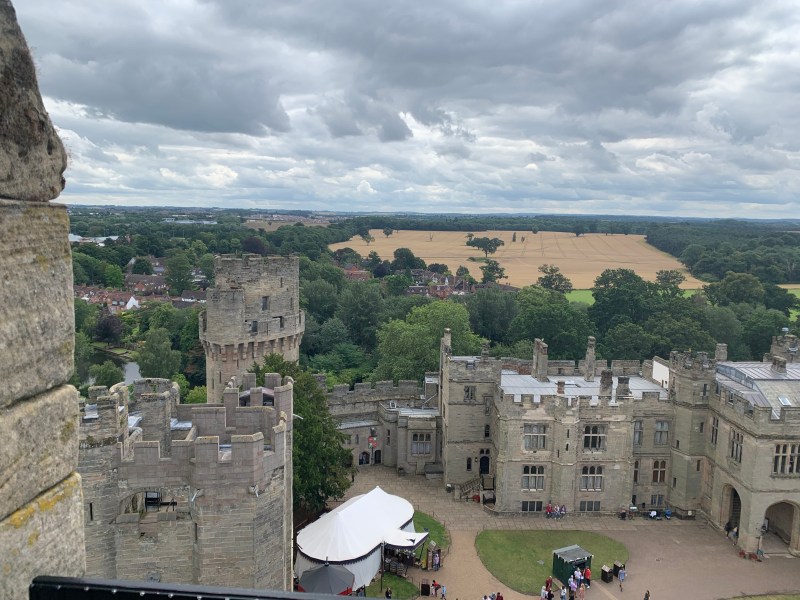For us, as Americans, England is a many faceted place of fairie tales, age old stories, castles and dreams. In many ways, England, and the British Isles are our mother country. Our legal system, our culture, even some of our cuisine are all rooted in Britain. We may have rebelled in 1776 for good reason, however, it could be argued that we never stopped loving our mother country. Consider our current fascination with Britain’s Royal Family if you doubt our love for all things British.
If you love literature, as I do, England is a place of enchanted castles and timeless tales of heroes. For a lover of literature, there is no better place than England. Jim and I stayed in London for a week, and because we don’t have children, we were able to explore the museums, the castles and the pubs where history happened. We were fortunate to take a side trip out through the Cotswolds to Warwickshire, Warwick Castle, Oxford and Stratford.
While we walked through Warwick Castle, we could see the different periods in English history as it was first commissioned by William the Conqueror in 1068 and underwent several renovations over time. The great hall had been left as it had been during medieval times, but the upstairs was refurbished in the 1800s. We continued to the man made mound at the end of the castle which is belieed to have been commissioned by Aethelflead at the end of the 800s. It is certainly the remains of an old baily. I had read Bernard Cornwall’s series, The Saxon Tales, with my father, in which Aethelflead and her father, Alfred, play a large role. It was a surreal experience to stand on a mound perhaps created by a formidable woman who lived so long ago during the Anglo Saxon Period. I found myself texting my father that I felt like I just stepped into a Bernard Cornwall novel. From the mound, we had a breathtaking view of the surrounding countryside. For me, standing on Aethelflead’s Mound, as it is still called, was a real life connection to the Anglo Saxon period and Aethelflead, the Lady of Mercia as well as the Bernard Cornwall books.
Next, we went on the Stratford to tour Shakespeare’s house. Yes, the house of the Bard himself still survives. I found out that it was to have been demolished in the 1800s, but for the efforts of Charles Dickens and his friends who worked to see that it was preserved. Walking through the house where the Bard was born and raised made him seem that much more real. At one point, I touched a door frame with my fingertips and whispered to Jim, “He was here. Shakespeare was here.” I almost couldn’t breathe as I walked the same steps he had walked so long ago. I had hoped to also see the first folio, which is often on display in the house, however it was not on display while we were there. It was still more than gratifying to walk the steps that Shakespeare walked. Much of the rest of Stratford is touristy, and there is a large outdoor market with all sorts of trinkets to buy. We bought handheld pastries with bacon, leeks and cheese and walked through the market with them. Delicious! Stratford is also where the Royal Shakespeare Theater is housed. Sir Patrick Stewart (Captain Picard, Star Trek the Next Generation) Sir Ian McKellan (Gandalf in Lord of the Rings) and Dame Judi Dench (M in several Bond movies) were all well regarded members of the Royal Shakespeare Theater long before they became famous in Hollywood. If you are there when a play is happening, it’s a definite must. After all, the play is the thing.
We then went to Oxford and toured the parts of the campuses open to the public. We couldn’t go in, but we saw Exeter, the school where J. R. R. Tolkien taught. The medieval architecture of Oxford is stunning, and exactly what we Americans envision it to be, maybe even more beautiful. Oxford has an incredibly old library, but we chose to go into the local bookstore instead. Oxford is, of course, the home of the Oxford Press which published most of the books I read for my college courses, so the bookstore was extensive. Then we had to hunt down the pub where J. R. R. Tolkien and C.S. Lewis met their friends, the Inklings, to talk about their literary ideas, the Eagle and the Child, or the Bird and the Baby, as locals call it. We drank a pint in honor of Tolkien and Lewis. I had to investigate the entire place, and told Jim that I couldn’t believe we were drinking where Tolkien and Lewis drank. I think I pinched myself to make sure I wasn’t dreaming.
You don’t have to love literature to love Oxford, Stratford and Warwick Castle, but I felt as if my love of literature and history gave me a deeper appreciation of the places. I felt the literature I loved come alive as I walked the steps that my favorite authors walked long ago. For me, Oxford, Stratford and Warwick Castle were not just touristy places for photo ops. These were the places where my favorite authors lived, wrote, and history happened. Go to Oxford, Stratford and Warwick Castle for the history, the architechture, the literature, and of course, the pubs. Have a hand held bacon, leek and cheese pastry while you are there.




